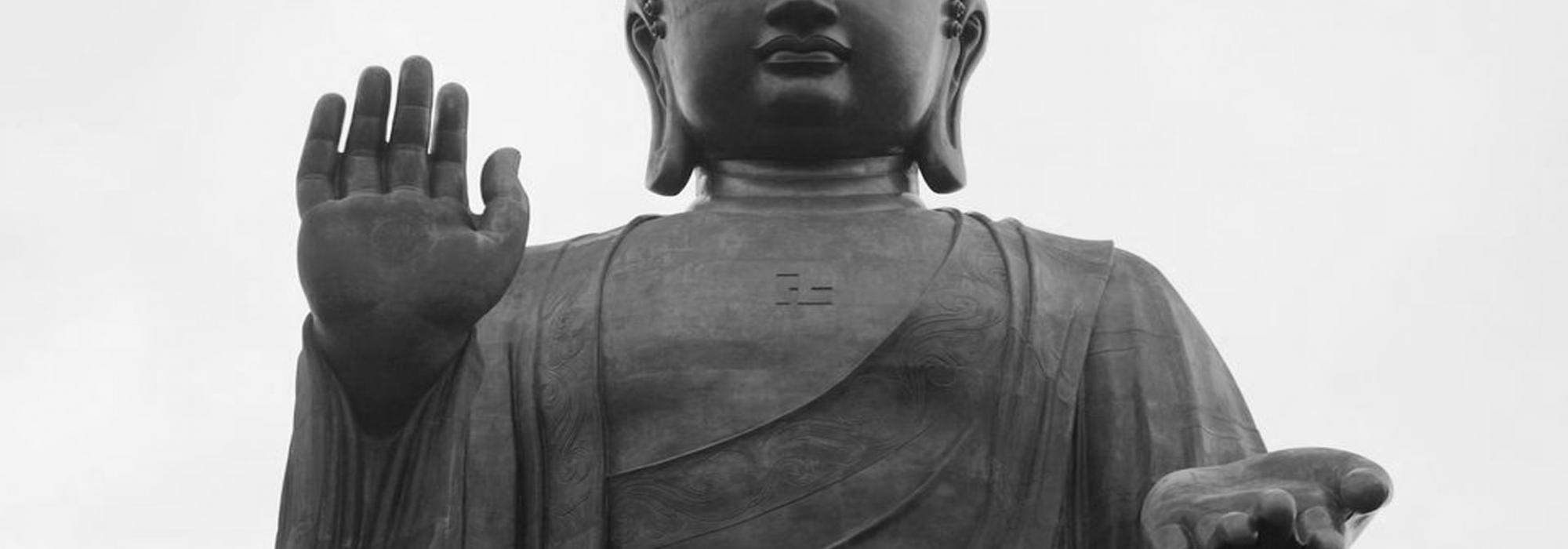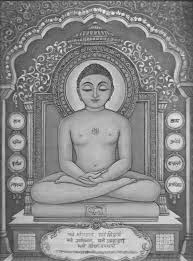There was a gap of about three hundred years between Buddha and Aśoka. Buddha lived in the 6th century BCE. He was born in 560 BCE. He saw the effulgence of kṣātra in his surroundings. He had seen the lacunae and failings of the system of republics. Even so, he felt that one should support the war that is fought out of love for one’s freedom. Today Buddha has become a symbol for the cowardly pseudo-secularism. Buddha was a person who sincerely upheld Vedic values. It is due to the Communists [Marxist historians] that he has wrongly been portrayed today as a rāja-virodhi (lit. ‘anti-king’), an anti-establishment figure, as someone who was against kings. In fact, Buddha camped at several spots that were near the palaces of renowned kings. And among his great devotees were kings of those days. During the time Buddha left his palace and roamed about in the jungle, Śreṇyaka Bimbisāra met him and said, “You are such a brilliant person; so resplendent. If you don’t want the kingdom of your father Śuddhodana, come with me. I will give you a portion of the Magadha Empire. You can live happily there!” Buddha replies, “No, I have no such desires.” We know that even when he was Siddhartha, and before his enlightenment, he knew many kings well. After his enlightenment, he was intimately friendly with Bimbisāra, the Magadha emperor, and later with his son Ajātaśatru. Buddha was also compassionate towards Prasenajit (Pasenadi) of Śrāvasti, who had been a victim of many weaknesses. The insanity of Prasenajit is world-famous. We find these details in the foundational works of Buddhism. In his palace, there were several schemes and dealings, intrigues, and fights. In spite of this, Buddha always maintained a supportive stance towards Prasenajit. Buddha was also friendly towards Udayana Vatsarāja, a great connoisseur of the arts but a fickle-minded man. In Udayana’s capital, Kauśambi, Buddha conducted several cāturmāsyas (this was earlier called varṣāvāsa). He was also friendly with King Brahmadatta who ruled over Kāśi. He had strong connections with the various kṣātra-gaṇas, i.e. republics such as Malla, Madra, Śākya, Koliya, and Vajji. He had amicable relationships everywhere. Further, Buddha treated with great courtesy Sudatta and Anāthapiṇḍada, who were wealthy vaiśyas with a flourishing trade with far-off islands. He would reside in vihāras [monasteries] that were specifically built for him, by kings, princes, traders, and the wealthy; he would also accept bhikṣā (alms) from them. None of this is one bit inappropriate. There merely indicate the Buddha’s samadarśitva (looking at everyone with the same eye). We’re only protesting the manner in which the Communists have cleverly concealed these details! Buddha was amicable not just to commoners but also to kṣatriyas. That is the reason why the Suttapiṭaka records in detail his conversation with Siṃhasenāpati, the leader of the Licchavis and the commander-in-chief of the Vṛji-gaṇa (the Vajji Republic). Those interested can take a look at the Sehasutta.
Vardhamāna Mahāvīra and Buddha were contemporaries. Several records indicate that Vardhamāna was 25-30 years older than Buddha. Both had undertaken cāturmāsyas at Vaiśāli, which was the center of the Licchavis. In fact, Vardhamāna Mahāvīra was born in the Licchavi Republic. Thus he is called ‘Nigrantha Jñātṛputra;’ here, jñātṛputra refers to a relationship of cousins. He was a relative of Licchavis. Mahāvīra called Buddha an ‘akriyāvādi,’ i.e. ‘one who was not for the revival of karma and kṣātra;’ ‘one who has not instructed anything.’ (Buddhists texts are the basis for this. Jaina texts say quite the opposite!) Upon hearing this, Siṃha (Seha) goes to Buddha and asks him, “Are you an akriyāvādi? That is what our Vardhamāna Mahāvīra claims.” In response Buddha says, “I am definitely not an akriyāvādi! I am a kriyāvādi. I have never ignored karmayoga, punishments by the king, individual freedom, or the fulfilment of responsibilities. I merely advocate the Middle Path. I only say that nothing should go to the extremes.” The primary characteristic of Sanātana Dharma is the adherence to the Middle Path.
Once when Buddha was in the same Vaiśāli, the Licchavis asked him, “There are repeated attacks on the Licchavis from the Magadha Empire, primarily at the command of Ajātaśatru. We fought against Śreṇyaka Bimbisāra himself but now he is dead. His son Ajātaśatru is constantly waging war against us. How do we protect our freedom, our sovereignty, and our eminence?” Then Buddha tells them the saptaśīla, the seven virtues.
Saptaśīla – The Seven Virtues of Buddha
In response to the query of the Licchavis, Buddha preaches the saptaśīla, the seven tenets. In this regard, the great patriot and scholar Sita Ram Goel has authored a wonderful novel in Hindi entitled Saptaśīl.[1] Buddha addressed the Licchavis thus: “You will retain your independence as long as you all stay united. Your freedom will remain intact only as long as you discard your internal fights, attend the Saṃsthāgāra (Assembly at the centre of the Republic), actively participate in every discussion and debate, and be ready to abandon all work and take up arms with warlike enthusiasm the moment the battle drum is beaten. You need not fear any enemy as long as you firmly adhere to your laws that are rooted in values, revere the wise and the elderly, respect the womenfolk, follow traditions of the various philosophical schools without fail, and respect and follow the teachers of the various philosophical schools. This doesn’t apply just to the Vṛji-gaṇa but is a life-giver for any nation.”
If a democracy has to survive, it requires constant vigilance, dynamism, and intellectual vigour on the part of the citizens. The moment war is declared, all differences should be set aside and the entire country should unite as the physical embodiment of an undivided army. This is the kṣātra preached by Buddha. Buddha says that the protectors of the nation must constantly have the mindset of an armed warrior and must lead a life based on values. Buddha has indeed prescribed a life of renunciation, but to whom? In the Vinaya-piṭaka, Buddha has clearly enunciated that the bhikkhus must be well-versed in war tactics and methods of self-defence (Buddhism travelled from India to China, Japana, Korea, etc. They have beautifully utilized the martial expertise of the bhikkhus. And our own people have completely forgotten it – what a tragedy!) During the seventh century CE, in the Nālanda University, Āyurveda and martial arts were compulsory subjects for both students and saṃnyāsis.
Wasn’t Ashoka aware of all this? The decline of Buddhism had already begun by his time (c. third century BCE). Ashoka repented at the personal level for the violence that had unleashed, and this is laudable indeed. But then, his imposition of this principle on the State’s military policy was a disaster. He might have been great as an individual but from the perspective of the interests of the State’s well-being, his weakness is evident. As a result of this misplaced policy, the Greeks became stronger once again. The rule of the kṣatrapas (Satraps) begin; they reach all the way to Ujjaini in Central India. Fortunately, the social-cultural-spiritual construct of Sanātana-dharma is extremely robust. Owing to this reason, it was able to comfortably assimilate the Greeks. They learnt Sanskrit with greater zeal than the Sanātana-dharmis themselves! They learnt the Vedas and the Itihāsas. They wholeheartedly tried to integrate themselves with the cultural world of the country. Chiefly this was possible because unlike Islam/Christianity, the religious tenets of the Greek, Śaka, and Kuśāna invaders allowed them to do so. If this was not so, the blood-soaked history of India of the last thousand years stands witness to what might have happened otherwise.
Translated from the original Kannada by Sandeep Balakrishna and Hari Ravikumar.
Footnote
[1] This novel was authored in response to Nehru’s destructive policy of ‘Panchasheel’ (which he foolishly pursued with China). The language of the novel in itself is excellent. In the name of ‘Hindustani’ Gandhi forcibly stuffed Urdu and Persian words in the Hindi language. How exactly did Hindi evolve? It evolved from the amalgam of Braj, Maithili, Avadhi, and Bhojpuri, and had its roots in various Prakrit dialects. All those Prakrits had their roots in Sanskrit. In their deluded fascination for ‘Hindu-Muslim bhai-bhai,’ the Nehru-Gandhi duo polluted the foundations of an entire language. What’s more, by writing Urdu in the Devanagari script, they made people believe that this indeed was Hindi and Hindustani, thus defrauding them. Muslims didn’t learn Hindi neither did the Hindi of Hindus survive. This was the damage done. Today, we see hardly any connection between the ‘Khadiboli’ Hindi used in daily life and that of the Banarasi (spoken in and around Varanasi), Avadhi (Lucknow), Maithili (Bihar), and Bundelkhandi (Madhya Pradesh). All these have become adulterated. It is for this reason that in order to propagate chaste Hindi, Sita Ram Goel has written in ‘Mitiboli’ Hindi. All South Indians can easily understand this. Therefore it will be convenient for all of us if Hindi rich in Sanskrit-Prakrit is used. In fact, this adulteration of Hindi is also one of the reasons why the Tamils oppose the language with such vehemence. In reality, Sanskrit should have been the national language of India. This was stopped by Rajendra Prasad. No matter how hard people like Ambedkar tried, it was futile. In this regard, Ambedkar’s follower Maurya has written: “I made a huge fuss against Sanskrit. But Ambedkar’s desire was that Sanskrit should become the national language of India. I foolishly opposed him due to my prejudices and committed a blunder. Therefore Ambedkar had to withdraw, his wishes unfulfilled.” In this manner the Sanskrit that was easily accessible to everyone was distanced and a great foundation was laid for severing the relationship between South and North India.










































